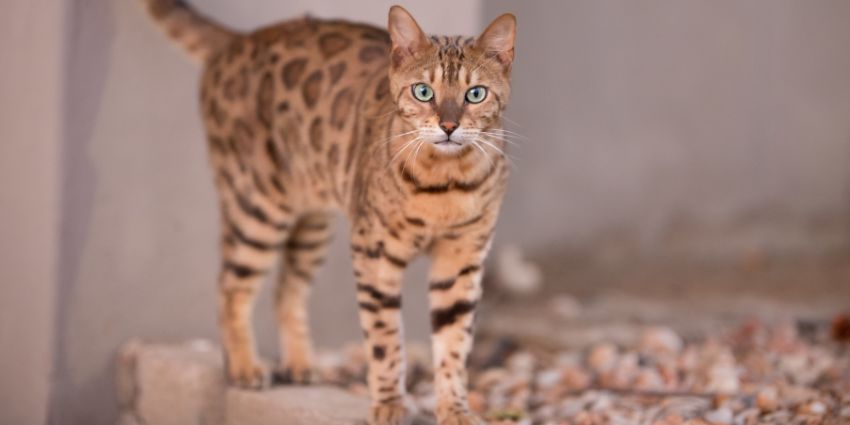Cats are amazing animals with interesting stories. In this blog, we’ll look at the key differences and similarities between African Wildcats and domestic cats.
We’ll learn about their behavior, where they live, and how they have changed over time. Whether you love cats or are just curious, this blog about wild and domestic cats will be fun and easy to understand. Let’s find out what makes each of these cats special and how they are connected.

Physical Differences
Cats come in all shapes and sizes, especially when comparing African Wildcats and domestic cats. Both types of cats share a common ancestor, but they have evolved differently over time. These differences can be seen in their appearance, behavior, and where they live. By understanding these differences, we can learn more about these beautiful animals.
African Wildcats are the wild cousins of our domestic cats. Their homes are in Africa and they are adapted to living in the wild. Domestic cats, on the other hand, have been living with humans for thousands of years and have adapted to life in our homes.
In the text below, we will focus on the physical differences between African Wildcats and domestic cats. We’ll start with their size and weight, then move on to their coat and markings, and finally, their tail and ears. This will help us see what makes them different and what makes them similar.
1. Size and Weight
African Wildcats are usually a bit bigger than domestic cats. They weigh between 8 to 15 pounds, while domestic cats usually weigh between 6 to 10 pounds. This means wildcats are often stronger and more muscular.
African Wildcats are about 18 to 24 inches long, not including their tails. Domestic cats, on the other hand, are usually around 15 to 20 inches long. Even though the size difference isn’t huge, it can be noticed when you see them side by side.
2. Coat and Markings
African Wildcats have a unique appearance with short fur that’s sandy-colored, which helps them blend into their environment. Their fur usually has light stripes and spots, and that helps them hide in the wild. They also have a reddish line running down their backs and rings around their tails.
Domestic cats have many different colors and patterns. Their coats can be short or long, and they can have stripes, spots, or solid colors. This happens because people have chosen which cats to breed, which creates lots of different kinds of cats with different looks. Some domestic cats look similar to their wild cousins, but many have very different and unique markings.
3. Tail and Ears
The tails of African Wildcats are usually a bit thicker and have black rings with a black tip. This helps them with balance and communication in the wild.
Domestic cats have tails that come in all shapes and sizes. Some have long, thin tails, while others have short, fluffy ones. Their tails can also be straight or curled. This, again, happens because people have been breeding cats for a long time to have specific traits.
When it comes to ears, African Wildcats have larger ears compared to their heads. This helps them hear better, which is important for hunting. Domestic cats also have good hearing, but their ears come in many different shapes and sizes, depending on the breed. Some have big, pointed ears, while others have small, rounded ears. This diversity makes domestic cats unique and different from their wild relatives.
Behavior and Temperament
African Wildcats and domestic cats are different when it comes to behavior, but they also share some things in common.
African Wildcats are great hunters, while domestic cats don’t hunt because they usually get food from their owners.
Understanding how cats hunt and eat, and how they interact with others, helps us know more about them. Let’s take a closer look at these things to see what makes African Wildcats and domestic cats special.
1. Hunting and Feeding
African Wildcats are really good at hunting because they have to find their own food in the wild. They use their sharp claws and they move quickly to catch animals like mice or birds. It’s how they survive.
When it comes to domestic cats, they usually don’t have to hunt for food. Their owners give them food to eat. Some domestic cats might still like to chase toys or play with things that move like prey, but they don’t have to hunt for their meals like wildcats do.
2. Social Behavior
African Wildcats are mostly loners. They love to live and hunt alone, and they only come together to mate. They mark their territories with scent and try to avoid other cats.
Domestic cats can be social, but it depends on the cat. Some enjoy being around people and other pets, while others prefer to be alone. If they like you, they will purr, rub against you, or sit on your lap. Each cat has its own personality when it comes to socializing.
Habitat and Range
African Wildcats live in Africa, in places like savannas and woodlands. They’re adapted to surviving in these wild areas, where they hunt for food and find shelter.
Domestic cats live in all sorts of places. Some live in cities, where they can explore streets and alleys. Others live in the countryside. They can adapt to different environments because they’ve been living with humans for a long time.
Communication and Vocalizations
African Wildcats and domestic cats have different ways of talking and showing how they feel.
African Wildcats use different sounds, like growls, hisses, and purrs, to talk to each other in the wild. They also use body language. For example, they raise their fur when they’re scared or crouch down low when they’re about to catch something.
Domestic cats have learned to meow in ways that humans can understand. They might meow when they’re hungry, want attention, or just want to say hello. Some cats even have different meows for different things, like a loud meow for food and a soft meow for a greeting. They also use body language, like rubbing against your leg or flicking their tail, to communicate with humans. It’s important to understand how they move and the sounds they make to know what they want. If you want to know more about how cats act and become closer to them, check out our Guide to Understanding Cat Language.
Conservation and Coexistence
African Wildcats are important to the ecosystems where they live, but their numbers are getting smaller. This is because of habitat loss and hunting. People are working to protect them by creating places where they can live safely and by making rules to stop hunting them.
Domestic cats, when they’re not kept indoors, can sometimes hurt local wildlife. They might catch birds or small animals for fun or because they’re hunting. This can be a problem for the environment. Pet owners need to keep their cats indoors or use things like collars with bells to reduce their impact on local wildlife.
Conclusion
African Wildcats and domestic cats may seem different, but they actually have a lot in common. These cats have their own ways of surviving, from how they hunt and communicate, to where they live. Learning about them helps us see how special they are and why it’s so important to keep them safe.
By learning about African Wildcats’ natural habitats and the impact of domestic cats on local wildlife, we can work together to keep both wild and domestic cats safe and healthy.



